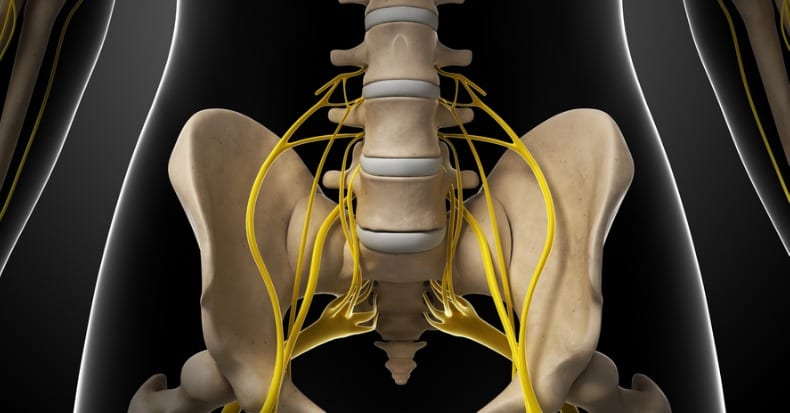The sciatic nerve is made up of five nerve roots that exit the spine in the lower back (L4 to S3) and then merge into one nerve that travels through the buttock and into the leg. At the back of the knee, the nerve divides into two nerves, the tibial and common peroneal, that travel into the inner and outer lower leg and foot.
When the sciatic nerve is compressed or pinched, a patient can feel pain, tingling, numbness, and even weakness in the hip, buttock, and leg. For individuals under the age of 60, the most common cause of sciatica is a herniated disk. For older adults, the most likely causes of sciatica are spinal stenosis (a narrowing of the openings of the spine the nerves travel through) and spondylolisthesis (when one vertebra slides forward on the neighboring vertebra).
Normally, a nerve root moves freely in and out of the spine through holes located between each vertebra called intervertebral foramen (IVF). Movements or exercises such as hamstring stretches or punting a football create tension on the sciatic nerve and pull the nerve roots out of the IVFs. Similarly, when we stand up straight and look down at our feet, this pulls the spinal cord upward and the nerve roots move into the IVFs.
When managing sciatica, chiropractors will utilize a technique called nerve flossing. Like flossing teeth, the back and forth motion of the dental floss is conceptually the same action as the back and forth motion of the five nerve roots that merge into the sciatic nerve. To pull the nerve roots out of the IVF, extend the head/neck upward and then flex the foot/ankle upward as well (toes toward the nose). To pull the nerve back into the IVF, point the foot/ankle downward while the head/neck flexes forward (chin to chest). Repeat multiple times as long as pain or other symptoms do not worsen. The idea behind this is to free up the nerve root by reducing adhesions in the IVF.
Nerve flossing is usually performed first by a doctor of chiropractic to make sure it is well tolerated and safe so that the patient can perform the exercise at home several times a day. Studies show that this method helps reduce tension on the sciatic nerve while also stretching the hamstrings, which are often tight in patients with low back pain.
Thousands of Doctors of Chiropractic across the United States and Canada have taken "The ChiroTrust Pledge":
“To the best of my ability, I agree to
provide my patients convenient, affordable,
and mainstream Chiropractic care.
I will not use unnecessary long-term
treatment plans and/or therapies.”
To locate a Doctor of Chiropractic who has taken The ChiroTrust Pledge, google "The ChiroTrust Pledge" and the name of a town in quotes.
(example: "ChiroTrust Pledge" "Olympia, WA")
Content Courtesy of Chiro-Trust.org. All Rights Reserved.

